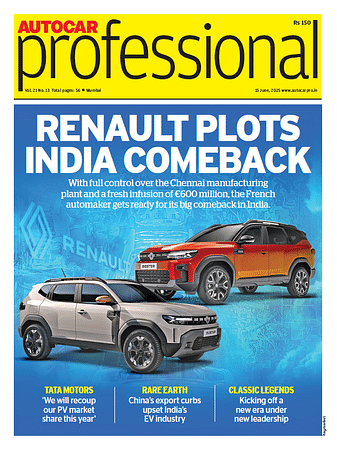Hot Stamping is India’s Smart Route to Lightweight, Cost-Effective EVs: Gestamp’s Sachin Bhoutkar
Advanced hot stamping and giga stamping offer cost-competitive alternatives, but early OEM collaboration is key, says R&D BiW India Director Sachin Bhoutkar.
The global automotive industry is in a relentless race to shed weight, driven by stringent emissions regulations, safety standards, and the burgeoning demand for electric vehicles. While aluminum and novel composites frequently grab headlines as lightweighting solutions, Sachin Bhoutkar, Director of R&D BiW India at Gestamp—a specialized multinational company in the design, development, and manufacture of highly technological engineered components for the automotive industry—argues that advanced steel technologies, particularly hot stamping, offer a compelling and often more cost-effective path forward for the Indian market.
His insights underscore a strategic pivot toward high-strength steel solutions and a call for deeper, earlier collaboration between suppliers and original equipment manufacturers (OEMs). Bhoutkar spoke during a panel discussion at a virtual vehicle lightweighting conference organized by Autocar Professional on June 12–13.
Forging Strength, Cutting Weight
Gestamp is no stranger to the complexities of material formability, having honed its expertise for more than 25 years—especially with hot stamping materials, a technology in which the company is a global leader. This includes sophisticated hot and cold stamping and roll-forming simulations using tools like LS-Dyna, AutoForm, Copra, and others, leveraging significant in-house knowledge to tackle challenges.
Bhoutkar highlighted that hot stamping technology allows for the use of materials with significantly increased strength, reaching up to 1500 MPa. This elevated strength enables fundamental design changes, leading to considerable reductions in vehicle weight, fewer individual parts, and thinner gauges.
For instance, Gestamp globally employs high-strength steels with roll-forming technology with an ultimate tensile strength (UTS) of 1500 MPa for components such as rockers and seat crossmembers. Despite this advanced capability, he noted that different raw material variations can cause discrepancies between simulated formability results and real-world try-out outcomes. Thanks to its advanced technological knowledge, Gestamp addresses these discrepancies and collaborates with steelmakers to acquire the material properties needed for better correlation between simulation and try-outs.
The Collaboration Imperative
A recurring theme in Bhoutkar's discussion was the absolute necessity of early and in-depth co-design and co-development with customers. Gestamp supports this vision by collaborating with local partners and adapting its processes to meet regional demands effectively.
He stressed that such collaboration is essential because of Gestamp’s expertise in offering OEMs highly engineered solutions to tackle mobility challenges.
"The concept defines how you are going to meet the cost," he stated, emphasizing that early engagement with customers to define and validate the design concept on the full vehicle is crucial for managing costs effectively. While Gestamp is already bringing advanced high-strength steel (AHSS) and ultra-high-strength steel (UHSS) in hot stamping technology, he noted that it becomes "a viable business case" if OEMs design vehicles with the availability of such technology in mind.
Cost-Efficiency Through Consolidation
In a market perpetually sensitive to costs, Bhoutkar asserted that Gestamp's solutions—particularly those leveraging hot stamping—are quite cost-competitive. He specifically addressed the Indian market's unique cost landscape. As a strategic, cost-effective counterpoint in India, Gestamp is a pioneer in Ges-Gigastamping®, its proprietary family of giga stamping products.
He offered a compelling example of Gestamp’s Door Ring, where four distinct parts—the B-pillar, sill, hinge pillar, and A-pillar—are integrated and stamped as a single component. This innovation not only reduces overall weight and simplifies the assembly of multiple parts but also allows for reduced gauge, enhances the product's safety and integrity, and supports CO₂ reduction targets, all while remaining cost-competitive.
He positioned these Ges-Gigastamping® solutions as a strong counter to giga casting, implying a strategic alternative to other emerging manufacturing trends.
Way Forward
Bhoutkar suggests a future where advanced steel solutions, supported by deep supplier-OEM collaboration and innovative manufacturing processes like giga stamping, will play a central role in achieving lightweighting, environmental goals, and cost efficiency in the Indian automotive sector. This strategic focus on ultra-high-strength steel offers a robust pathway for manufacturers navigating the complex interplay of regulatory demands, material costs, and evolving vehicle architectures.
RELATED ARTICLES
Cabinet Approves ₹1 lakh crore RDI Scheme to Fuel Sunrise Sector Innovation
The RDI Scheme is designed to address key constraints in financing private R&D initiatives by offering long-term, low or...
Honda Motorcycle & Scooter India Sales Decline 17% YoY in June
Company expanded road safety and EV outreach alongside product launches in June.
Tata Motors Cedes Ground to MG and Mahindra in Electric PV Market
MG and Mahindra command more than 53% of the electric PV market, a dramatic reversal from a year ago, when Tata alone he...





 By Shahkar Abidi
By Shahkar Abidi
 18 Jun 2025
18 Jun 2025
 1614 Views
1614 Views





 Arunima Pal
Arunima Pal




